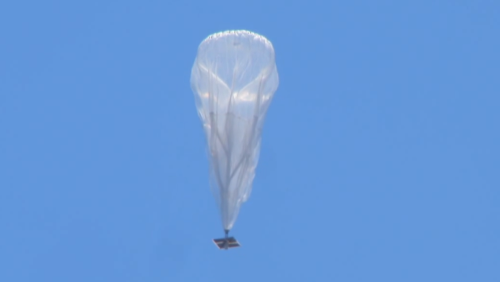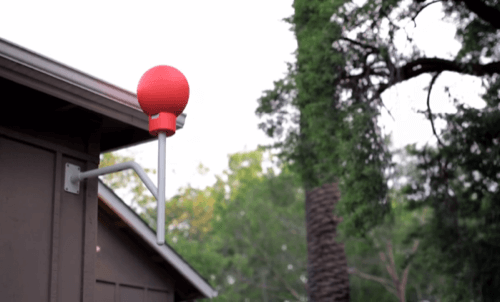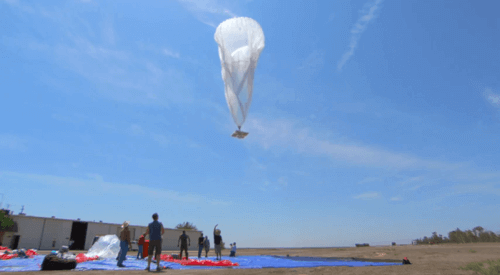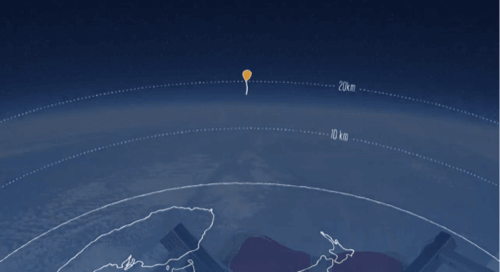No one can accuse Google of not thinking big. Project Loon, Google’s audacious “moonshot” vision to bring mobile Internet connectivity to the billions without – via balloons – is one of the company’s biggest ideas ever. It’s madness, but it just might work.

Considering the uniqueness of the idea, its use of old technology, and the potential impact it will have should Google succeed, you no doubt have questions. Here is a handy Q&A guide to help you understand Project Loon.
Balloons? Really?
Yes, really. The balloons are made of polyethylene plastic. They are approximately 15 meters in diameter and the entire apparatus is about 12 meters tall. Each balloon is powered via solar panels.
The balloons will float along the winds in the stratosphere, approximately 20km above the surface. At such a distance, they cannot be seen with the naked eye. Each balloon is equipped with transceivers to communicate with nearby balloons and with a regional ground station and the specialized antenna Google developed to receive the signal.
While only 30 test balloons were used at launch, Google expects far more floating in the sky should this project prove viable. Google says the balloons will provide mobile data connectivity equivalent to today’s 3G speeds, or possibly greater.
How Does It Work?
Each balloon is networked to one another with a radio transceiver as in a mesh, designed to ensure signal reliability. A second transceiver keeps the balloon in contact with a network station on the ground and beams an Internet signal to specialized antennas that can be placed on homes, much like a very small satellite TV receiver.
There is also a back-up transceiver and a GPS on each balloon, so Google can monitor a balloon’s location. And each balloon will carry weather instruments, too.
Is This Just A Publicity Stunt?
Unlikely. Driverless cars seemed like a publicity stunt, as did Glass. Google has a way of surprising people with both the scope of their vision and its willingness to push it into reality. From the Project Loon announcement:
We believe that it might actually be possible to build a ring of balloons, flying around the globe on the stratospheric winds, that provides Internet access to the earth below. It’s very early days, but we’ve built a system that uses balloons, carried by the wind at altitudes twice as high as commercial planes, to beam Internet access to the ground at speeds similar to today’s 3G networks or faster. As a result, we hope balloons could become an option for connecting rural, remote, and underserved areas, and for helping with communications after natural disasters.
That said, Google also states that “this is still highly experimental technology and we have a long way to go.”
What Will Project Loon Be Used For?
According to Google, for 2 out of every 3 people on Earth, “a fast, affordable Internet connection is still out of reach.” Project Loon is an early, inspiring attempt to deliver reliable connectivity to those areas where it does not exist or is prohibitively expensive – the Southern Hempishere, in particular.

Google also mentions the ability to deliver communications using its balloons following natural disasters. Disasters such as Hurricane Sandy, which devastated Haiti last year before striking the U.S. East Coast, can cripple a region’s communications infrastructure for an extended period. Loon could potentially serve as a helpful backup grid.
Is This Just A Plot To Sell More Ads?
Maybe. But does it matter?
Of course, nearly all Google’s revenues come from advertisements posted onto connected screens large and small. The more people connected, the more advertisements. Google wins. This is its bold project, after all.
The Tech

Google has been tight-lipped regarding exactly how this will all work. Project Loon technology includes, at minimum, the balloons, transceivers, terrestrial control equipment, on-board battery, solar panels and GPS, network monitoring equipment and terrestrial antennas that connect to Project Loon balloons. (These earthbound antennas resemble – you guessed it – red balloons; one is pictured at left – or above if you’re on a mobile device.)
The company has suggested that at this early stage, humans will be needed to monitor the system and individual balloons. This is a problem Google hopes to eventually resolve using “complex algorithms and lots of computing power.”
Won’t The Balloons Float Away?
Yes! Only not much as you might suspect. Google claims to have “figured out” how to control the balloons by moving them up or down into the desired band of wind in the stratosphere, though it didn’t specify how, exactly.
The stratospheric winds and temperatures should presumably not present a hazard problem for the balloons or equipment.
Should Google really ramp up this project to the point where it involves hundreds or even thousands of balloons, controlling the entire system will pose some pretty complex challenges. Do not be surprised to one day read a story about a Loon balloon landing on some farm in South America, for example.
Is This A Google X Project?
Yes, and it certainly seems like Google X is about the coolest place to work for in all of tech. The company states that Project Loon is just its latest “moonshot” effort.
Has This Been Tried in the Real World?
Yes. Google ran its first public test last weekend, in New Zealand, sending 30 balloons into the sky and offering 60 lucky volunteers 15 minutes of balloon-based Internet access. Smaller, private tests were conducted in California and possibly elsewhere.
The company says that “over time” it intends to set up similar pilots in countries with the same latitude as New Zealand (40th parallel south). It hasn’t provided any timeline for these pilots.
How Much Does All This Cost?

You won’t be surprised to learn that Google hasn’t specified what spent on this project, nor how much it intends to spend. Neither has the company offered any cost data for any of the equipment used or any indication of how many of its own employees are Loonies. All this is par for the course for Google.
As for (eventual) end users, it seems reasonable to assume that Google plans to deliver Internet connectivity expects its solution to ultimately cost less than satellite-delivered Internet, or be scrapped.
Ultimately, the costs may prove worth it. As my ReadWrite colleague Matt Asay noted in April:
Google is giving away hugely expensive fiber-based Internet access (in the U.S.), but not because it’s a charity. Google knows that the more people that spend time online, the more likely they will spend money with Google.
Will The Balloons Crash?
Each balloon is made of rugged polyethylene plastic. They use solar power to help remain aloft. The balloons float in the stratosphere, above rain and commercial aircraft, for example, and far below satellites.
Of course they will crash.

Google says each balloon includes a parachute to ensure a more controlled landing – not a crash, per se. The company adds that the balloons are designed to stay aloft for “100+ days.”
When a balloon is known to have reached its end of life or needs repair, controllers can arrange an orderly descent. Google has plans for designated Loon balloon collection points. Google has also suggested that the balloons and equipment on board can be re-used and recycled.
Google will notify the appropriate authorities, such as air traffic controllers, during both launch and descent.
Where Can I Get Updates?
Project Loon has its own Google+ page.
Wait. Are the Skies Open?
Not, especially. There are many rules regarding airspace and who controls it, and also disagreements as to how far (up) such control extends.
Floating in the stratosphere means that almost certainly, Google will always be required to seek permission from any government whose airspace the balloons float into. In addition, while this project uses unlicensed spectrum, there’s no guarantee that will always be the case.
Luckily for Google, approximately 70,000 weather balloons are launched every year, which may mitigate some, though not all, of the legal and regulatory issues.
Can I Get Balloon Powered Internet?
If you are reading this, then probably not. This solution is not intended for you. As Google states:
There are many terrestrial challenges to Internet connectivity—jungles, archipelagos, mountains. There are also major cost challenges. Right now, for example, in most of the countries in the southern hemisphere, the cost of an Internet connection is more than a month’s income.
Given that Google can control the positioning of the balloons, it could – in theory – bring Loon to areas that have suffered connectivity outages following a disaster or conflict, for example.
Will This Be Another Failed Last Mile Solution?
We’ll see. As Google notes, most people don’t have affordable and reliable 3G-like access. This is obviously a difficult problem to solve.
Google has been working on delivering wireless connectivity using “white spaces” – publicly available radio spectrum – since at least 2010. Microsoft has just announced it’s joining a multi-organization effort to bring white spaces connectivity to underserved areas (such as rural communities) in Europe. Typically, such efforts function similar to today’s cellular networks – and most certainly do not use balloons.
Many efforts to bring WiMax, a high-speed wireless service for more densely populated areas, were clear failures, despite early hype. Similarly, satellite-delivered Internet, which has succeeded for many, continues to remain relatively expensive and fraught with issues such as line-of-sight, visibility, and cost.
Google has said that, at minimum, balloons offer the potential for widespread, affordable Internet access. And that’s clearly a big part of the company’s mission when you consider Project Loon, the company’s other white spaces efforts and its Google FIber business in the U.S. True, it’s also a self-interested mission. But that doesn’t mean it’s not a good thing.
Images via Google Project Loon









